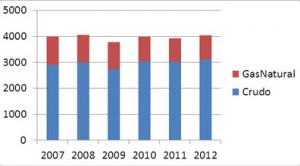The Future of Cuban Oil Prospecting
Jorge Piñon* (Cafe Fuerte)

HAVANA TIMES — Cuba has just announced it will drill the deepest oil well of its prospecting history. The planned 8,200-meter-deep well speaks to the extensive technical capacity of current prospecting efforts on the island.
The announcement, made by the State-operated Cubapetroleo (CUPET), reported that work on the well would begin this year, with prospecting efforts and the drilling of new wells in a development area to the west of the city of Matanzas. The project is part of mainland based operations that have been in development for years in coastal areas of Cuba’s northeastern region. Last year alone, ten new wells were drilled in the area, six of them using CUPET equipment.
The news were made public following US former senator Bob Graham’s visit to the island. Graham visited Havana last week as part of a delegation interested in addressing issues surrounding oil spill prevention and preparedness in the region.
Cuban Oil Production
The world’s deepest horizontal well – measuring 12,345 meters (40,502 feet) and boasting a horizontal depth of 11,475 meters (37,648 feet) – was drilled by the US multinational Exxon at the Odoptu oilfield, in Sakhalin, Russia, on January 28, 2011.
Cuba produces approximately four million tons of oil a year, three million of which are in the form of crude oil and a million as natural gas, which is used as fuel to generate over 1,875 GWh of electricity by ENERGAS (a joint venture operated by the Canadian company Sherrit), CUPET and Cuba’s Union Nacional Electrica (“National Electrical Company”).
CUPET produces 80 percent of Cuba’s extra-heavy crude. The remaining 20 percent is produced by the joint-venture operated by Sherrit. This oil is extracted through superficial horizontal wells drilled in fields to the north of Matanzas (in Puerto Escondido, Boca de Jaruco) which tap deposits located several miles from the coast.
The primary recovery rate for Cuban crude is 7 percent, owing to the viscosity of the crude and the porosity of the geological structures in the region. Cuba has great potential for increasing its recovery factor (up to 17 and even 20 percent), provided it can put to use enhanced oil recovery technologies, such as those that use injected vapor, liquid or gas, that can increase domestic crude production.
 Enhanced Oil Recovery Technologies
Enhanced Oil Recovery Technologies
The mere 1 percent increase in oil extraction afforded by Enhanced Oil Recovery (EOR) technologies around the world would be equivalent to an additional 20 to 30 billion barrels of oil. In essence, EORs have a twofold purpose: to reduce oil viscosity and facilitate its flow and to literally squeeze this oil out through rocky formations.
The extra-heavy crude produced in Cuba is used as fuel to generate electricity and accounts for 50 percent of energy production in the country. Cuba’s total oil demand is of approximately seven million tons of crude and derivatives. As such, domestic production meets a mere 40 percent of the energy demand.
The remainder is met through the import of some five million tons of crude, all of which is processed at Cuban refineries located in Regla, Santiago de Cuba and Cienfuegos. A small surplus of gasoline and turbo-fuel is exported to international markets by the Cienfuegos refinery, a joint-venture company made up of CUPET and Venezuela’s State-run oil company, PDVSA.
In the short term, any of hope of increasing oil production in Cuba is to be found in EORs, not in deep-well prospecting in the Gulf of Mexico.
Enormous Challenges
Though recent deep-water prospecting undertaken by multinational companies has not been fruitful, the study on Cuban oil reserves conducted by the US Geological Service (USGS) cannot simply be dismissed as wrong. Reports from reliable sources seem to indicate that such reserves are located in a geological structure that is difficult to access and therefore poses serious technical and financial challenges to prospecting efforts.
Cuban deep-water oil prospecting faces enormous technical challenges and political obstacles that aren’t easy to negotiate. It is an onerous activity surrounded by political difficulties, such as those the Spanish oil company Repsol had to overcome while operating its platform (Scarabeo 9) in Cuba, where it spent some US $ 200 million until 2012.
It is worth recalling that, in order to undertake deep-water drilling off Cuban coasts, the platforms used must be assembled using less than 10 percent US-made pieces, to avoid incurring in a violation of the US embargo related restrictions that bars companies from working on US projects for six months. This represents a high prime over the real rental cost for the operator.
As an example, the Scarabeo 9, which meets these technical requirements strictly, is currently operating in Angola under a five-year contract, and any prospect of returning to Cuban waters is quite remote.
The same holds for oil equipment and services that must be sought in Canada or Europe (and entail extra costs of around 15 to 20 percent), instead of closer markets such as Houston or New Orleans.
We must also bear in mind Cuba competes with more profitable regions such as Brazil, Guyana, Western Africa and, more recently, the deep waters of the Gulf of Mexico under the jurisdiction of the Mexican government.
—–
* Associate Director of the Latin America and Caribbean Energy Program at Austin Jackson School of Geoscience’s Center for International Energy and Environmental Policy (CIEEP).






Let’s not import those 5 million tons of crude & turn those 3 refineries into distilaries!
So let me get this straight: Because Cuba was limited to at least four known failed attempts to locate recoverable crude beneath Cuban seas (Spain, Venezuela, Vietnam and Brazil) at a cost to foreign drilling operations exceeding $700 million, the blame should largely fall on the US embargo. Furthermore, as these drilling attempts which began in earnest in 2011, it is your claim that these failed attempts “quite adequately put the lie to the claims” that 55 years of economic failure must be caused by the US embargo. And tooth fairies and leprechauns are real….
Communism does not even work on paper. It replaces discretionary productivity by coercive state mandates. The Cuban experiment was a human disaster as it lead to formation of a lazy class as Raul Castro has called out. The errors of the revolution now being corrected will reintroduce some measure of market to compliment the state enterprises.
Can you point to any other Communist society that has EVER actually succeeded …even China finally threw in the towel. But wait! JG says there have never really been any true communist government (a no true Scotsman, but that’s another story) Yet you say Cuba is failing because of the embargo, yet if that were the case how would Cuba have succeeded if there were no embargo? …Just trying to wrap your head around JG’s thought process is enough to lead you to drink…oh what the heck, It Friday!
According to Jorge, Cuba’s primary recovery rate is 7%. The worldwide average is said to be 10%. This implies that Cuban crude reserves are either more difficult to recover or the method of recovery is less efficient or both. Secondly, the use of EOR methodology to enhance recovery is again said to increase production by an average of 5% but if Jorge is correct that production will only increase 1%, it hardly seems worth it given the higher costs of extraction. Even the use of prior (not the latest generation) EOR technology is higher up the cost curve than standard extraction methods and demands broad-based production and refinery economies of scale. At a mere 4 million tons of crude per year, it is not economically justifiable at current world crude prices to engage these higher recovery and production costs. At first glance, it appears that Cuba’s plans for a mainland-based operation will follow down the same path as the abandoned deepwater drilling flight of fantasy.
The last four paragraphs of this piece quite adequately put the lie to the claims of people like Moses and I.C. that it is the inherent failings of Cuba’s “Communism ”
and not the U.S war in Cuba’s economy that is the problem in Cuba’s economy.